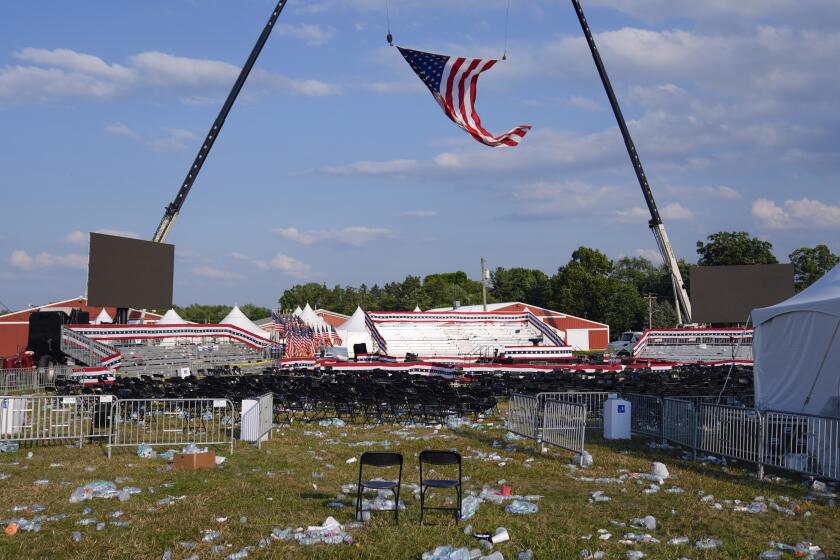Making the switch to digital TV easier
Two days before the nation’s television stations switch off their analog signals, the acting chairman of the Federal Communications Commission visited Los Angeles to warn that too many Southern California residents still weren’t ready for the change Friday to all-digital TV broadcasts.
Michael J. Copps said he feared that as many as 20% of households in major U.S. cities still rely on over-the-air analog broadcasts. Most of those households are non-English speaking, elderly or low-income, he said.
Copps, sporting a blue oxford shirt emblazoned with a Digital Television Transition logo, criticized the outreach efforts made under the Bush administration. President Obama postponed the date for the transition to June 12 from Feb. 17. That gave public agencies time to reach more homes.
In a visit Wednesday to The Times, Copps made a number of points:
--
How do you think the transition is going to go?
I think things are going to go considerably better than they would have gone had we gone ahead on Feb. 17.
They will not go as well as they would have gone had we been sufficiently serious about this four years ago instead of four months ago.
--
What was not being done to help people prepare?
No. 1, we should have done this in a more transitional phase rather than just all at one time, just like they did in the U.K. Second, we lacked any commitment to do any in-home assistance so that you could help provide assistance to people who were senior citizens, people with disabilities or people for whom English is not their primary language.
We lacked walk-in centers and help clinics. We didn’t have an adequate coupon converter program. Our program ran out of money in January of this year. Had we gone ahead in February, we would have had a consumer backlash of considerable magnitude. Now there will still be some level of disruption, but it’s better than it would have been.
--
What have you been able to do in the last four months?
We’ve turned the Federal Communications Commission into a grass-roots organization. We’ve gone from being a regulatory agency staying in our building on the shore of the Potomac River to actually getting people out.
We have more than 200 field agents out in 20 or more markets to do outreach. We put together a call-center operation. Starting today, it’s 24/7. We’ll have up to 4,000 operators this weekend to be on duty answering calls.
They’ve been trained to answer questions, and if they can’t answer them, they’ll know where to put those callers. We put a website together, DTV.gov, where you can do lots of neat things like find out whether they are broadcasting digital signals in your ZIP Code.
--
What about in-home assistance?
We have a lot of help available that we didn’t have before. We actually got people going out to do home installations. We got a deal with AmeriCorps where we have a lot of their volunteers going into people’s homes and connecting boxes. A lot of fire departments around the country have volunteered to help install boxes. Church groups and civic groups have also stepped up to the plate.
--
What is the public getting in return?
They’re getting better television. They’ll have a sharper picture. It won’t be HDTV, obviously, but it’s a better picture than what you had before, better sound. There will be more free broadcast channels because they can now multicast. You can put out four, five or six channels where you had one before.
And it’s a wonderful opportunity for broadcasters to reflect the local culture, the diverse ethnic groups, the diverse religious groups in their programming. There’s local politics, local music, bands, local orchestras and city council meetings.
So it opens up a whole array of possibilities to enhance the civic dialogue, to enhance entertainment, to reflect the cultures within a community and get other cultures seen. It can really serve the public interest.
--
Give us an update on the coupon program that initially stopped sending out coupons when it ran out of money. Is there still money for more coupons?
The Commerce Department has done a terrific job of clearing up the backlog in January in a matter of weeks. People can apply for coupons through the end of July, unless it runs out of money before then.
The turnaround time now is 12 to 14 calendar days. And they’re now sending out the coupons using first-class mail, instead of third-class mail like they were before.
--
Will there be enough converter boxes on store shelves?
There might be some spot shortages. Again, if there’s a last-minute rush for these things or people buy them even if they don’t need to, then you never know.
You have to realize that most of these things are built overseas. The production lines have been shut down. To start them up again takes weeks, and it would take weeks again to get them on ships across the blue waters to get here.
--
--
(BEGIN TEXT OF INFOBOX)
SoCal stations
Here are major Southern California stations and the times Friday they plan
to go digital:
- KCBS 1:10 p.m.
- KNBC 11:30 a.m.
- KTLA 10:45 p.m.
- KABC noon
- KCAL 1:10 p.m.
- KTTV *
- KCOP *
- KSCI 11 a.m.
- KCET *
- KFTR 11:27 p.m.
- KMEX 11:59 p.m.
- KVEA 11:35 p.m.
- KWHY 11:35 p.m.
- KOCE 11:30 a.m.
- KLCS 3 p.m.
* Between midnight and Saturday morning
-- Alex Pham and Meg James
More to Read
Sign up for Essential California
The most important California stories and recommendations in your inbox every morning.
You may occasionally receive promotional content from the Los Angeles Times.









